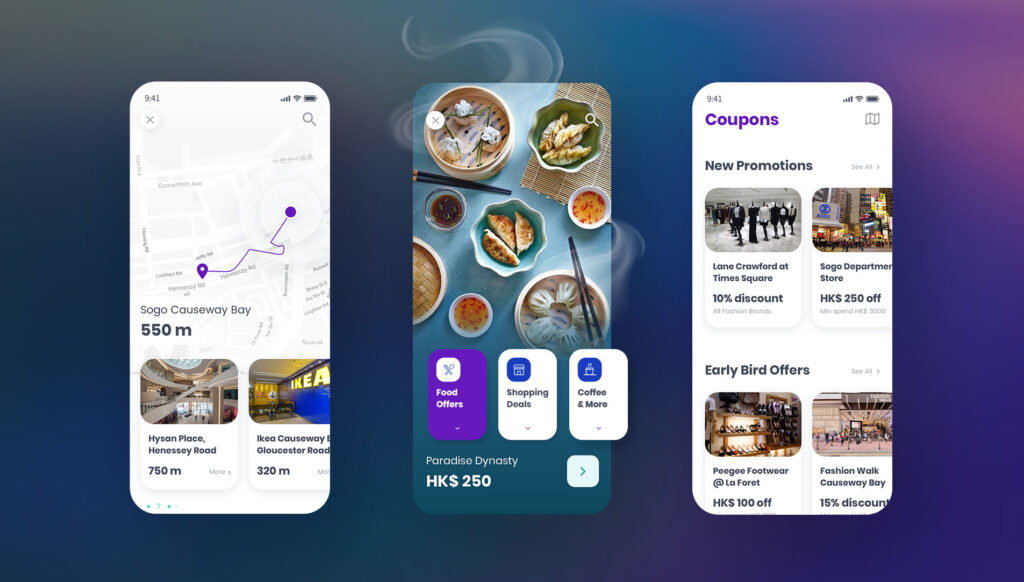The collaboration between User Interface (UI) and User Experience (UX) design plays a pivotal role in creating a seamless and engaging online experience. These two elements are the pillars that uphold the success of any modern website. Let’s delve into the intricacies of UI/UX design and understand how they work in harmony to elevate user satisfaction and drive business success.
Key Takeaways
- UI and UX are not interchangeable terms; UI focuses on the visual elements, while UX encompasses the overall user journey.
- A well-crafted UI enhances the aesthetics of a website, making it visually appealing and easy to navigate.
- UX design involves understanding user behaviors, conducting research, and optimizing the overall usability of a website.
- Striking a balance between UI and UX is crucial for creating a website that not only looks good but also delivers a seamless and intuitive user experience.
- Mobile responsiveness and accessibility are integral aspects of both UI and UX design.
Introduction to UI/UX Design
UI design is primarily concerned with the look and feel of a website. It involves the visual aspects such as color schemes, typography, and overall aesthetics. On the other hand, UX design delves into the user’s journey, from the moment they land on the site to completing a desired action. The synergy between these two ensures that a website not only looks visually appealing but also provides a user-friendly experience.
User Interface (UI) design is the artistic side of web development, focusing on the aesthetics and visual elements that users interact with. It incorporates graphic design principles, ensuring that the website is not only visually appealing but also aligns with the brand’s identity. The color palette, typography, and overall layout contribute to creating a captivating first impression.
User Experience (UX) design, on the other hand, is the science behind the user journey. It involves understanding the needs and behaviors of the target audience. UX designers conduct thorough research, create user personas, and map out the user flow to optimize the overall usability of the website. This involves ensuring that the navigation is intuitive, and users can effortlessly find the information they seek.
Importance of UI in Modern Web Design
A well-crafted UI is the first impression a visitor gets of a website. It involves creating an aesthetically pleasing design that aligns with the brand identity. With a thoughtful UI, users are more likely to engage with the content and navigate effortlessly through the site.
The significance of UI in modern web design cannot be overstated. The visual appeal of a website directly influences how users perceive a brand. A clean and visually appealing UI captures attention, communicates professionalism, and establishes a positive brand image. Consistency in design elements, such as color schemes and typography, contributes to brand recognition and reinforces the overall user experience.
Furthermore, UI extends beyond aesthetics; it encompasses the functionality of interactive elements. Buttons, forms, and navigation menus should not only look good but also respond seamlessly to user interactions. A well-designed UI ensures that users can easily comprehend and interact with the content, leading to a positive overall experience.
Navigating the UX Landscape
UX design is about understanding the user’s needs and tailoring the website’s structure accordingly. It involves conducting user research, creating user personas, and optimizing the overall usability. A seamless UX ensures that visitors can easily find what they are looking for, leading to higher satisfaction and increased conversion rates.
Navigating the UX landscape involves a deep understanding of user behavior. UX designers employ various research methods, such as user interviews, surveys, and analytics, to gather insights into user preferences and pain points. By creating detailed user personas, designers can empathize with the target audience and design an experience that resonates with their needs.
The optimization of usability is a core focus of UX design. This includes streamlining navigation, ensuring clear calls to action, and minimizing friction points throughout the user journey. A user-centric approach involves anticipating user needs and providing solutions before users encounter challenges. This proactive strategy contributes to a positive user experience, fostering loyalty and repeat visits.
The Interplay Between UI and UX
While UI and UX have distinct focuses, their interplay is crucial. A visually appealing UI should complement a seamless UX, creating a cohesive and enjoyable experience for the user. It’s not just about making things look good; it’s about making them work well too.
The interplay between UI and UX is akin to a well-choreographed dance. A captivating UI captures the user’s attention and invites exploration, while a well-thought-out UX ensures that the user journey is smooth and intuitive. The collaboration between these two design elements results in a holistic approach that considers both the visual and functional aspects of a website.
A visually striking UI sets the stage for a positive user experience. Engaging visuals draw users in and encourage them to explore the content further. However, without a solid UX foundation, the initial appeal can quickly wane if users encounter difficulties in navigation or fail to find the information they seek. Therefore, the interplay between UI and UX is essential for creating a harmonious and effective website.
Achieving Mobile Responsiveness
In the age of smartphones, ensuring a responsive design is paramount. Both UI and UX must adapt seamlessly to various screen sizes, providing an optimal experience for users regardless of the device they are using.
Mobile responsiveness is not just a trend but a necessity in the modern digital landscape. With a significant portion of internet users accessing websites through mobile devices, neglecting mobile responsiveness can result in a substantial loss of potential visitors. UI elements should adapt fluidly to different screen sizes, and UX considerations should prioritize mobile users’ needs for a smooth and enjoyable experience.
Moreover, the principles of mobile responsiveness extend beyond resizing elements. Touch-friendly navigation, concise content presentation, and optimized load times are integral aspects of ensuring a positive mobile user experience. A website that seamlessly transitions between desktop and mobile versions enhances accessibility and caters to the diverse preferences of users.
Best Practices for UI/UX Integration
1. Consistent Branding
Maintain a consistent visual identity across all pages, reinforcing brand recognition and trust.
Consistency in branding is more than just using the same logo and color palette. It involves creating a unified visual language that extends across all elements of the website. From the homepage to product pages and contact forms, maintaining a consistent branding strategy reinforces the brand identity and builds trust with users.
2. Intuitive Navigation
Design navigation menus that are clear, concise, and easy to follow, ensuring users can find what they need effortlessly.
Navigation is the roadmap that guides users through the website. An intuitive navigation menu simplifies the user journey, allowing users to navigate seamlessly from one page to another. Clear labeling, logical categorization, and easily accessible menus contribute to a positive user experience.
3. Minimalistic UI
Embrace simplicity in UI design to reduce clutter and enhance the focus on essential elements, improving user comprehension.
In a world inundated with information, a minimalistic UI stands out by focusing on the essentials. Streamlining the design, removing unnecessary elements, and prioritizing key information contribute to a clean and organized user interface. A minimalistic approach not only enhances visual appeal but also improves user comprehension and engagement.
4. User-Centric Approach
Prioritize user needs in UX design, anticipating their actions and providing solutions before issues arise.
A user-centric approach involves placing the user’s needs at the forefront of design decisions. By understanding the target audience, anticipating their behaviors, and addressing potential pain points, UX designers can create an experience tailored to user expectations. Proactively solving user challenges contributes to a positive user experience and fosters user satisfaction.
5. A/B Testing
Continuously test and optimize both UI and UX elements to enhance performance based on user feedback and data analysis.
A/B testing is a valuable tool for refining UI/UX elements based on real user interactions. By comparing two versions of a design element and analyzing user behavior, designers can make informed decisions to enhance performance. Regular testing and optimization ensure that the website remains aligned with user preferences and industry trends.
The Impact of UI/UX on E-Commerce
In the realm of e-commerce, UI and UX are critical for driving conversions. A visually appealing product page (UI) combined with a smooth checkout process (UX) contributes to a positive shopping experience, encouraging users to make purchases.
The impact of UI/UX on e-commerce goes beyond aesthetics. While an attractive product page captures attention, the overall user experience heavily influences purchase decisions. An intuitive and frictionless shopping journey, from product discovery to checkout, enhances user satisfaction and builds trust with potential customers.
High-quality product images, well-crafted product descriptions, and easy navigation contribute to a compelling UI that entices users to explore the product catalog. On the UX side, optimizing the checkout process, providing transparent shipping information, and implementing secure payment options contribute to a seamless transactional experience. The synergy between UI and UX in e-commerce is a driving force behind customer satisfaction and loyalty.
UI/UX in App Development
When it comes to app development, the principles of UI/UX extend to mobile applications. Creating an intuitive interface (UI) and ensuring a seamless user journey (UX) are paramount for app success.
App development requires a meticulous approach to UI and UX design due to the unique challenges of smaller screens and touch interactions. The UI of a mobile app should prioritize simplicity, ensuring that users can navigate the interface with ease. Icons, buttons, and interactive elements should be well-designed for optimal usability.
UX in app development involves considering the entire user journey, from the onboarding experience to regular usage. User flows should be intuitive, and the app should provide value at every interaction. Clear calls to action, minimalistic design, and seamless transitions contribute to a positive UX that keeps users engaged and encourages app retention.
Harnessing UI/UX for Digital Marketing
UI/UX plays a vital role in creating compelling and shareable content. A well-designed website (UI) coupled with an engaging user journey (UX) can significantly impact the effectiveness of digital marketing campaigns.
Digital marketing success relies on capturing and retaining the audience’s attention. A visually appealing and user-friendly website serves as the foundation for digital marketing efforts. The design elements, such as graphics, layout, and interactive content, contribute to creating a memorable and shareable experience for visitors.
Incorporating UI/UX principles into digital marketing campaigns involves aligning visual elements with campaign goals. Whether it’s an email marketing campaign or social media promotion, the design should be consistent with the overall brand identity. Additionally, optimizing landing pages for a positive user experience enhances conversion rates and supports the success of digital marketing initiatives.
Key Takeaways
The synergy between UI and UX design is the backbone of a successful modern website. Striking the right balance ensures that not only does a website look visually appealing, but it also provides users with a seamless and enjoyable experience. As technology advances and user expectations evolve, the collaboration between UI and UX will continue to shape the digital landscape, influencing how we interact with and experience the online world.
For personalized assistance and expert guidance in elevating your brand’s UI/UX design, WeCreate Digital Agency stands ready to transform your vision into a captivating digital reality. Wecreate is an award-winning, all-round digital marketing agency with offices in Amsterdam, Hong Kong, Singapore, Bali and Philippines. Our dedicated team is committed to crafting immersive experiences that not only meet but exceed user expectations. Feel free to reach out to us for any inquiries or to embark on a journey towards a visually stunning and user-centric digital presence. Your brand’s success begins with WeCreate Digital Agency.




